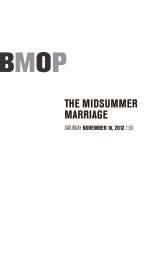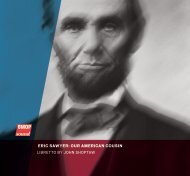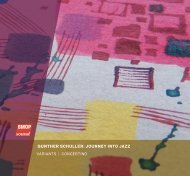Download the album booklet - Boston Modern Orchestra Project
Download the album booklet - Boston Modern Orchestra Project
Download the album booklet - Boston Modern Orchestra Project
Create successful ePaper yourself
Turn your PDF publications into a flip-book with our unique Google optimized e-Paper software.
is <strong>the</strong> signature tune for a long-defunct bbC murder-mystery series. It surfaces only<br />
twice, each time as a throwaway line, but its intervals control <strong>the</strong> whole. <strong>the</strong> sub-title is<br />
a dedication to <strong>the</strong> memory of bassoonist william waterhouse, who first performed <strong>the</strong><br />
work. he might not recognize it today, however, as it has been thoroughly revised for this<br />
recording.<br />
<strong>the</strong> sixth (violin) concerto, sub-titled mr. jefferson, presents <strong>the</strong> heaviest textural multilayering<br />
and <strong>the</strong> highest level of collage-quotation. Inspired by <strong>the</strong> figure of thomas<br />
Jefferson (next to einstein, history’s most distinguished amateur violinist), <strong>the</strong> work can<br />
be heard as a programmatic tone poem in five connected sections, celebrating Jefferson<br />
as inventor, violinist, gardener, lover, and <strong>the</strong> subject of <strong>the</strong> Gilbert stuart portrait, which<br />
hangs in <strong>the</strong> bowdoin College museum of art. <strong>the</strong> musical spelling of his name, especially<br />
<strong>the</strong> eFFe of Jefferson, runs through <strong>the</strong> entire work. In <strong>the</strong> second section, violin and<br />
harpsichord introduce fragments of music (by Vivaldi and Corelli, among o<strong>the</strong>rs), which tJ<br />
kept in his library. <strong>the</strong> fourth section, which recalls Jefferson’s intense relationship with<br />
composer-flutist maria Cosway during his ambassadorship in paris, brings flute and harpsichord<br />
toge<strong>the</strong>r in fragments of Cosway’s own music. <strong>the</strong>se passages are set against an<br />
increasingly chromatic fabric using Jefferson’s spelling, <strong>the</strong> letters of Cosway’s name, <strong>the</strong><br />
spelling of my own name, and <strong>the</strong> names of young women who’ve attracted my own fancy<br />
over <strong>the</strong> years (beginning with high school girl friends and, of course, including my wife)!<br />
Finally, during <strong>the</strong> concluding “portrait” section, as earlier motives are brought back, two<br />
patriotic revolutionary war songs rise to <strong>the</strong> surface.<br />
It’s worth noting that <strong>the</strong> Jefferson concerto has no cadenza (unless one counts <strong>the</strong> violin-harpsichord<br />
sampling of virtuoso baroque passages, always in danger of being buried<br />
by <strong>the</strong> orchestra). In fact, cadenzas—often <strong>the</strong> focal point of romantic-heroic concertos—are<br />
treated ra<strong>the</strong>r oddly here. In <strong>the</strong> double bass and clarinet concertos, <strong>the</strong>y are<br />
set against pianissimo “commentary” from <strong>the</strong> ensemble; <strong>the</strong> saxophone cadenza occurs<br />
while <strong>the</strong> soloist is walking; piano and bassoon cadenzas are mere asides, ra<strong>the</strong>r than<br />
soliloquies. In this regard, as in many o<strong>the</strong>rs, <strong>the</strong>se six works can be thought of as different<br />
strategies for dealing with <strong>the</strong> “concerto” principle—six variations, not on a <strong>the</strong>me,<br />
but on a genre.<br />
8 9










